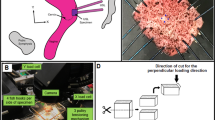Abstract
The uterosacral ligaments are thought to contribute to pelvic support. The objective of this study was to compare the structural components of these ligaments in women with and without pelvic organ prolapse (POP). We characterized uterosacral ligaments of 25 postmenopausal women with POP and 16 controls histomorphologically and immunohistochemically by quantifying their content of collagen I, III, and smooth muscle using a computerized image analysis. In 84% the uterosacral ligaments were composed of more than 20% of smooth muscle cells. There was no difference in collagen I expression and smooth muscle cell amount between women with POP and those without. In contrast, the collagen III expression was significantly related to the presence of POP (p<0.001) rather than age or parity. Our findings suggest that the higher collagen III expression might be a typical characteristic of POP patients’ connective tissue. The considerable amount of smooth muscle cells in uterosacral ligaments may provide pelvic support.



Similar content being viewed by others
References
Bump RC, Norton PA (1998) Epidemiology and natural history of pelvic floor dysfunction. Obstet Gynecol Clin North Am 25:723–746
Luber KM, Boero S, Choe JY (2001) The demographics of pelvic floor disorders: current observations and future projections. Am J Obstet Gynecol 184:1496–1503
Barber MD, Kuchibhatla MN, Pieper CF, Bump RC (2001) Psychometric evaluation of 2 comprehensive condition-specific quality of life instruments for women with pelvic floor disorders. Am J Obstet Gynecol 185:1388–1395
Samuelsson EC, Arne Victor FT, Tibblin G, Svardsudd KF (1997) Signs of genital prolapse in a Swedish population of women 20 to 59 years of age and possible related factors. Am J Obstet Gynecol 89:501–506
Brown JS, Waetjen LE, Subak LL, Thom DH, Van Den Eeden S, Vittinghoff E (2002) Pelvic organ prolapse surgery in the United States 1997. Am J Obstet Gynecol 186:712–716
Mant J, Painter R, Vessey M (1997) Epidemiology of genital prolapse: observations from the Oxford Family Planning Association Study. Br J Obstet Gynaecol 104:579–585
Olsen AL, Smith VJ, Bergstrom JO, Colling JC, Clark AL (1997) Epidemiology of surgically managed pelvic organ prolapse and urinary incontinence. Obstet Gynecol 89:501–506
DeLancey JOL (1992) Anatomic aspects of vaginal eversion after hysterectomy. Am J Obstet Gynecol 166:1717–1724
Amundsen CL, Flynn BJ, Webster GD (2003) Anatomical correction of vaginal vault prolapse by uterosacral ligament fixation in women who also require a pubovaginal sling. J Urol 169:1770–1774
Buller JL, Thompson JR, Cundiff GW, Krueger Sullivan L, Schon Ybarra MA, Bent AE (2001) Uterosacral ligament: description of anatomic relationships to optimize surgical safety. Obstet Gynecol 97:873–879
Ulmsten U, Falconer C (1999) Connective tissue in female urinary incontinence. Curr Opin Obstet Gynecol 11:509–515
Farnsworth BN (2002) Posterior intravaginal slingplasty (infracoccygeal sacropexy) for severe posthysterectomy vaginal vault prolapse—a preliminary report on efficacy and safety. Int Urogynecol J Pelvic Floor Dysfunct 13:4–8
Petros PE (2001) Vault prolapse II: restoration of dynamic vaginal support by infracoccygeal sacropexy, an axial day-case vaginal procedure. Int Urogynecol J Pelvic Floor Dysfunct 12:296–303
Petros PE, Ulmsten UI (1990) An integral theory of female urinary incontinence: experimental and clinical considerations. Acta Obstet Gynecol Scand Suppl 153:7–31
Bump RC, Mattiasson A, Bo K, Brubaker LP, DeLancey JO, Klarskov P et al (1996) The standardization of terminology of female pelvic organ prolapse and pelvic floor dysfunction. Am J Obstet Gynecol 175:10–17
Lehr HA, van der Loos CM, Teeling P, Gown AM (1999) Complete chromogen separation and analysis in double immunohistochemical stains using Photoshop-based image analysis. J Histochem Cytochem 47:119–125
Jackson SR, Avery NC, Tarlton JF, Eckford SD, Abrams P, Bailey AJ (1996) Changes in metabolism of collagen in genitourinary prolapse. Lancet 347:1658–1661
Liapis A, Bakas P, Pafiti A, Frangos-Plemenos M, Arnoyannaki N, Creatsas G (2001) Changes of collagen type III in female patients with genuine stress incontinence and pelvic floor prolapse. Eur J Obstet Gynecol Reprod Biol 97:76–79
Yamamoto K, Yamamoto M, Akazawa K, Tajima S, Wakimoto H, Aoyagi M (1997) Decrease in elastin gene expression and protein synthesis in fibroblasts derived from cardinal ligaments of patients with prolapsus uteri. Cell Biol Int 21:605–611
Makinen J, Kahari VM, Soderstrom KO, Vuorio E, Hirvonen T (1987) Collagen synthesis in the vaginal connective tissue of patients with and without uterine prolapse. Eur J Obstet Gynecol Reprod Biol 24:19–25
Yamamoto M, Aoyagi M, Akazawa K, Tajima S, Yamamoto K (1998) Decrease in p53 protein in cultured cardinal ligament fibroblasts from patients with prolapsus uteri. Cell Biol Int 22:31–40
Yamamoto M, Akazawa K, Aoyagi M, Yamamoto K (2000) Changes in biological characteristics during the cellular aging of ligament fibroblasts derived from patients with prolapsus uteri. Mech Ageing Dev 115:175–187
Liu S, Yang R, Al-Shaikh R, Lane J (1995) Collagen in tendons, ligaments and bone healing. Clin Orthop 318:265–278
Savvas M, Bishop J, Laurent G, Watson N, Studd J (1993) Type III collagen content in the skin of postmenopausal women receiving oestradiol and testosterone implants. Br J Obstet Gynaecol 100:154–156
Ewies AA, Al-Azzawi F, Thompson J (2003) Changes in extracellular matrix proteins in the cardinal ligaments of postmenopausal women with or without prolapse: a computerized immunohistomorphometric analysis. Hum Reprod 18:2189–2195
Acknowledgments
The authors thank Professor J. Schulte Mönting of the University of Freiburg for his assistance with the statistical analysis.
Author information
Authors and Affiliations
Corresponding author
Rights and permissions
About this article
Cite this article
Gabriel, B., Denschlag, D., Göbel, H. et al. Uterosacral ligament in postmenopausal women with or without pelvic organ prolapse. Int Urogynecol J 16, 475–479 (2005). https://doi.org/10.1007/s00192-005-1294-5
Received:
Accepted:
Published:
Issue Date:
DOI: https://doi.org/10.1007/s00192-005-1294-5




